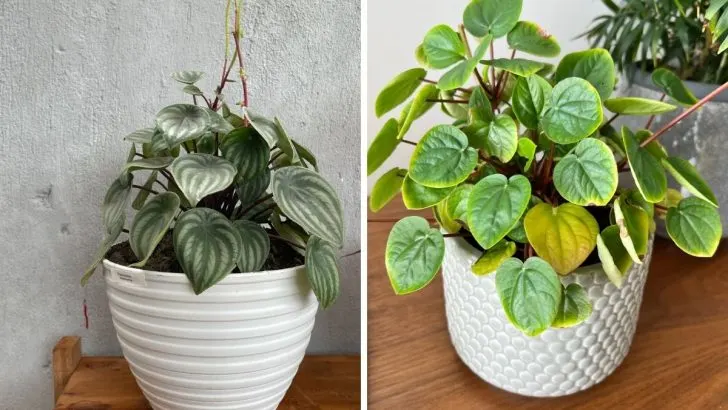It is time to get a trailing plant for your home. Lucky for you, today, we’re talking about the plants that have a lot of trailing varieties, about the most beautiful types of peperomia.
Other dwarf varieties will also be a great option for your home and as soon as you get it, you’ll notice that new fresh look it brought to your home.
Order a hanging basket, save some space for peperomia, make yourself some coffee and let’s start!
How Many Varieties Of Peperomia Are There?
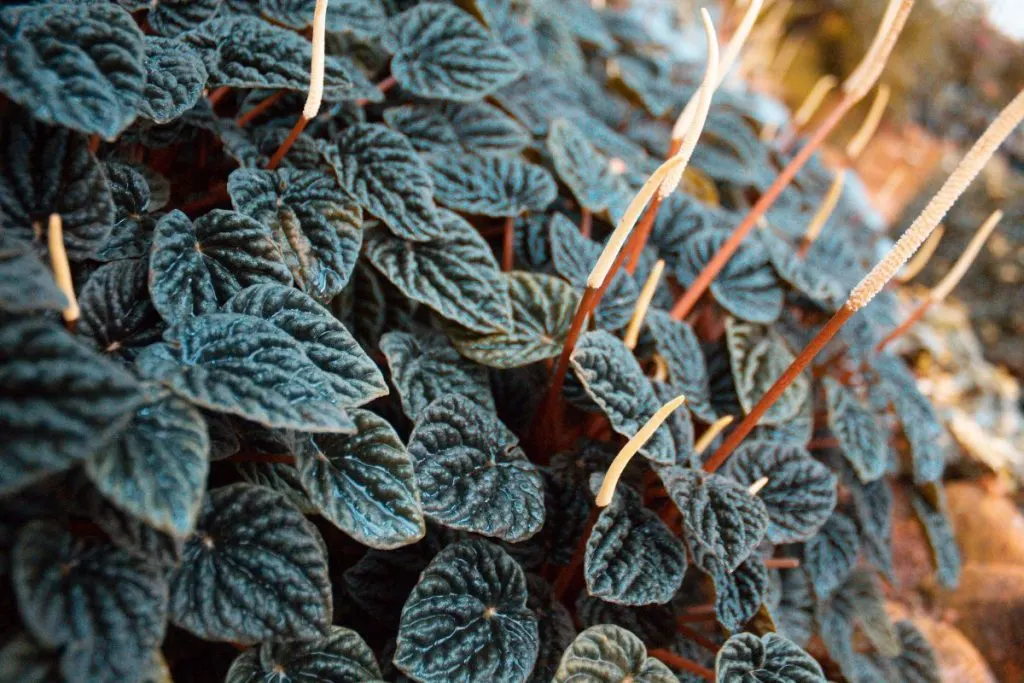
There are over 100 indoor species of peperomia, there are upright, bushy, and ample representatives of the flora of different colors.
Representatives of her family are so different from each other that when you look at them it is hard to believe their common origin.
I am sure that among the 100 different room variations you can find at least one that is ideal for you and your home.
Each of them is beautiful in its way and has many advantages. Before you get the adorable peperomia plant, read a little more about its varieties.
1. Baby Rubber Plant (Dark Green Peperomia)
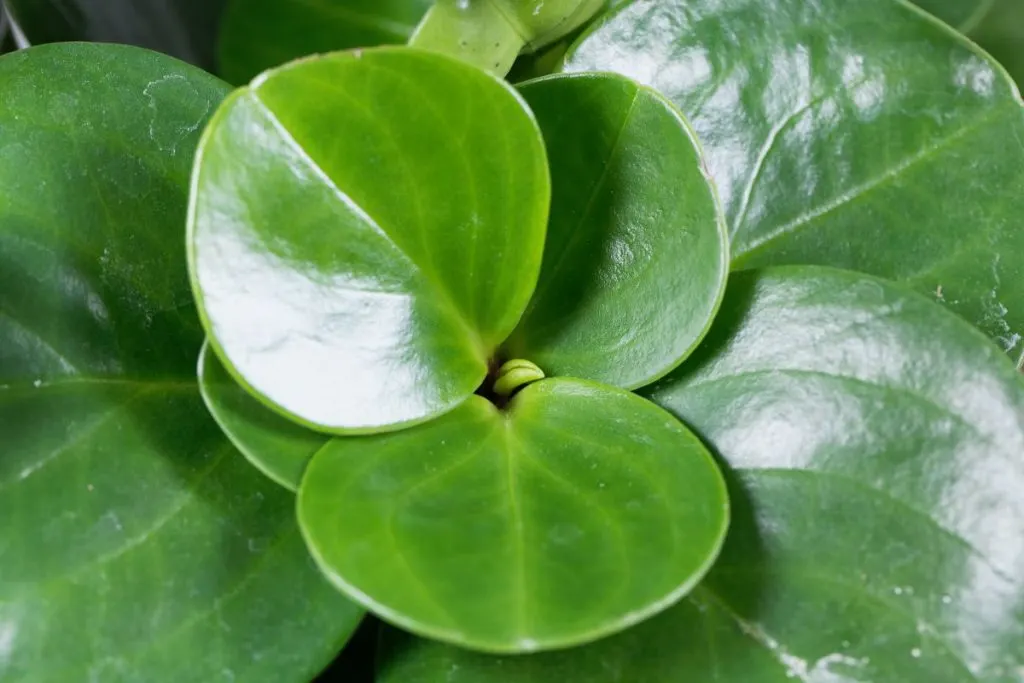
This evergreen perennial (Peperomia obtusifolia) can grow up to a foot and a similar width. The epithet obtusifolia means ‘blunt’. Some see it as one of the radiator plants. It is also called peperomia tupolista. This lovely plant is most commonly known as the baby rubber plant.
- Bright light but bright indirect light is best for your plant. Although short periods of direct light are fine, too much full sun will cause the leaves to change color. Partial shade is your best option, as the plant loves a little early morning sunlight.
- Consistent, light watering during the spring and summer months is important. Wait until the soil is almost dry on the surface before watering again, but do not allow it to dry completely. In late fall and winter, you can reduce the frequency of watering. It will take less during the colder months.
- Because its leaves contain a significant amount of moisture, this plant is mildly drought tolerant. Letting it dry too often can harm the leaves, but occasionally skipping watering won’t hurt.
- Peperomia is tolerant to most soils. It does not require clay, sand, or loam. Avoid soils that hold a lot of moisture on the epiphytic roots. Too much moisture can cause root rot.
- Strive for a liquid plant food every 3 weeks during the spring and summer months. Apply the fertilizer directly to the soil, not the leaves, to avoid burning the leaves.
- Stem or leaf cuttings are the best way to propagate a baby gum plant. They grow easily from both. Use root hormone-based cuttings to promote rapid root development.
- For aesthetic purposes, although circumcision is not necessary, it is often performed. Regular pruning can encourage more lush leaf development. Maintaining a certain size is also an option.
2. Watermelon Peperomia Care Guide
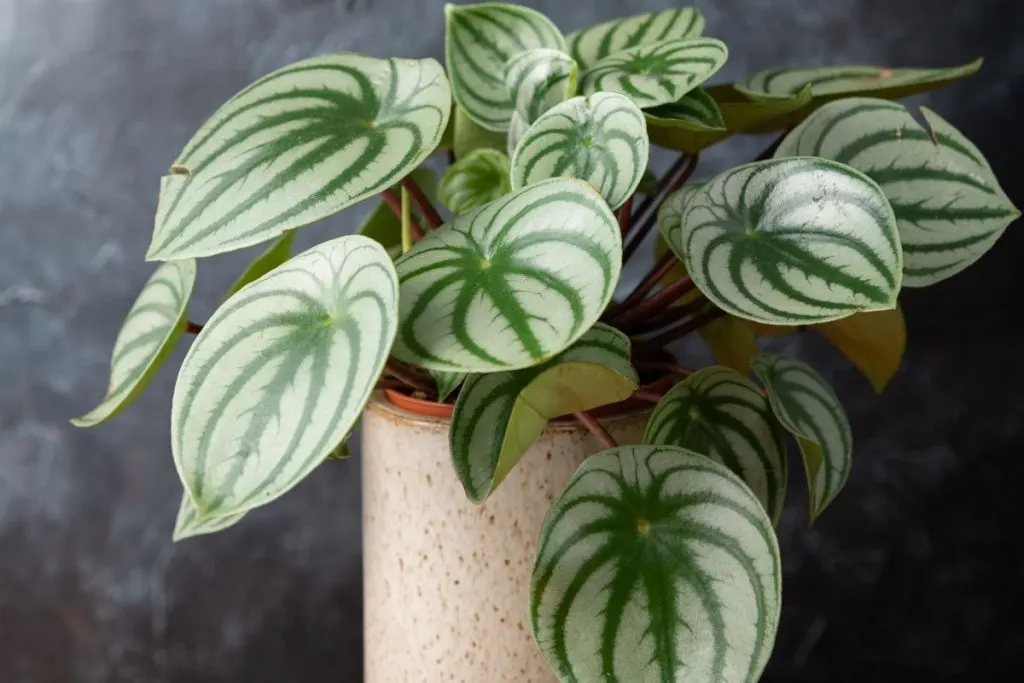
Watermelon peperomia is also called silver peperomia – (Peperomia argyreia). This variety is considered one of the most beautiful representatives of these genus plants. Its striped leaves are the most attractive. The alternating stripes of silver and dark green give it a resemblance to a watermelon, which is why it got its name.
- In summer the plant is watered when the top layer of soil dries, in winter – once every two weeks. If the indoor air is too dry, the leaves should be sprayed every day. Watermelon peperomia has a superficial root system, so watering must be done from above. The plant is particularly susceptible to flooding. After watering, you need to drain the water from the trough.
- Watermelon peperomia belongs to the colorful varieties that need diffused light. We advise you to place it on the east and west windows. In winter, the plant can be arranged with artificial lighting.
- Pruning peperomia watermelon is not mandatory, but it is desirable. Thanks to this procedure, the decorative effect of the flower increases. Upright shoots should be cut when they grow to 10 inches.
- Fertilize the plant from late spring to early autumn. They feed on complex mineral fertilizers.
- In spring or summer, you can propagate the flower by cuttings. Use a sharp knife to cut off the shoot on which one or more buds are located. Plant it in the substrate and cover it with a plastic bottle. For rooting you need to put the plant in a warm place. After 3 weeks, plant it in a small pot.
- The damage of watermelon peperomia is caused by thrips, whose larvae are on the lower surface of the leaves. Spider mites can be detected by blooming like a spider web. The flower can suffer from root rot.
Dark Green Leaves Peperomia Types
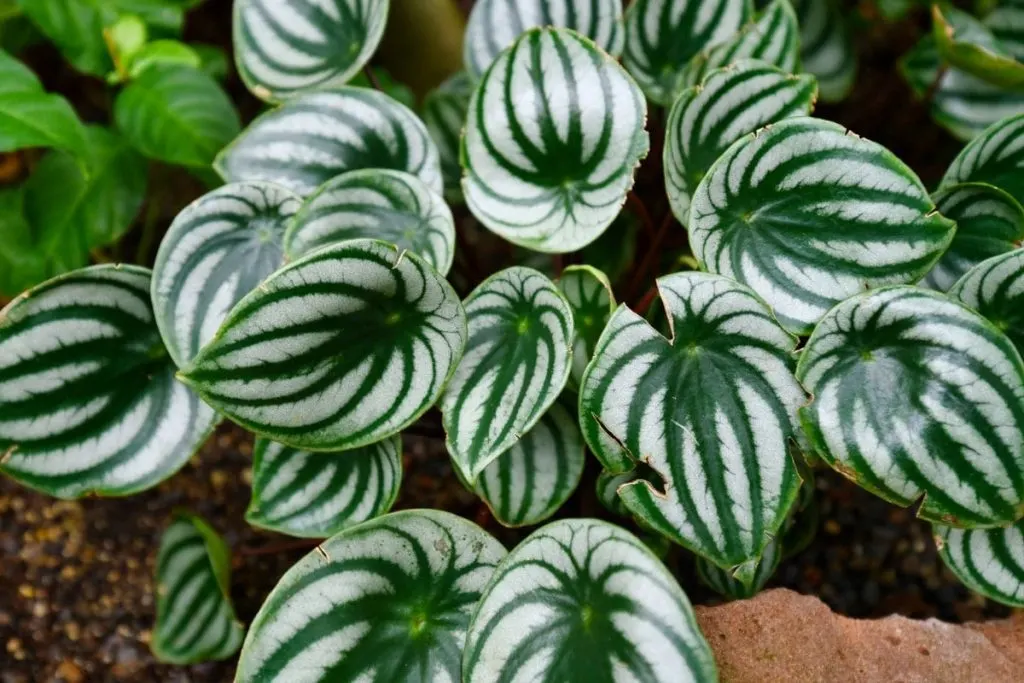
We all prefer glossy green leaves plants for our home. Those amazing waxy leaves on your table, your neighbor must be really jealous.
There is something truly special about plants with dark green leaves. Somehow, they seem fancier and more beautiful.
Of course, we can’t discuss tastes, but we can talk about the dark green leaves of peperomia plants. If you want some for your home, let’s find out more about them.
3. Beetle Peperomia For Your Home
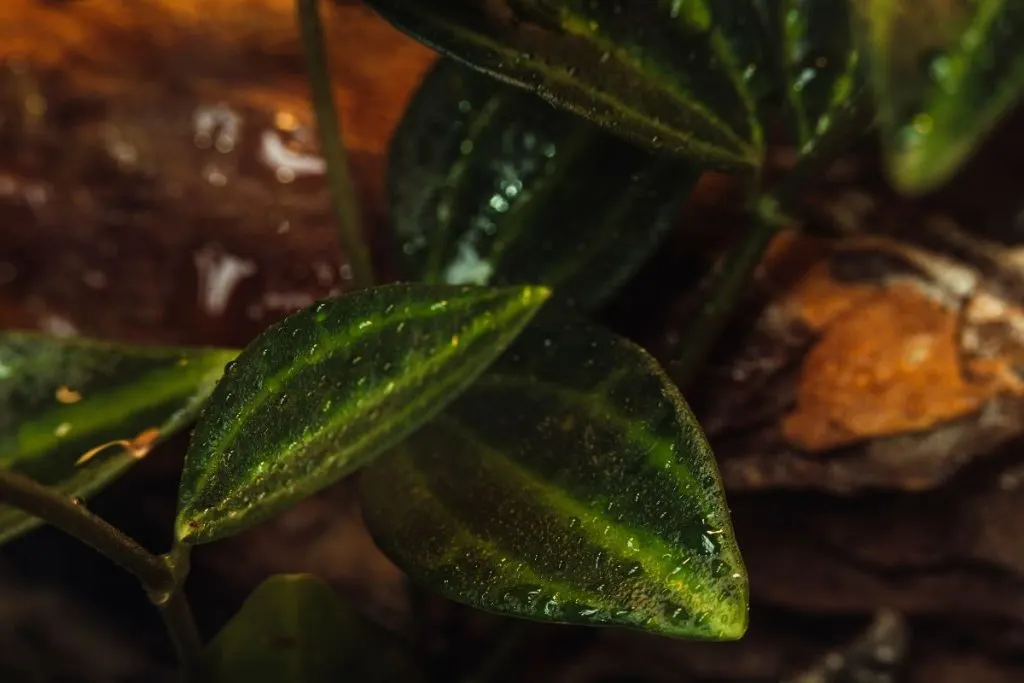
Peperomia beetle is a small houseplant with creeping stems. Dark green leaves have attractive lighter green stripes, which increases their year-round interest. This plant is also called (Peperomia angulata and peperomia quadrangularis).
- From excess light and prolonged exposure to direct sunlight, the leaves fade and may fall off. North-facing windows are suitable if the exposure of the plant is only brief.
- Like many houseplants that came to us from the tropics, the peperomia beetle does not tolerate cold. It can withstand a drop in temperature of up to 50 F for a short time.
- In winter it is better to move it from cold window sills deep into the room. The plant is faithful to the summer heat, subject to sufficient watering and proper lighting.
- The need for water is moderate in this species. Water it regularly, and partially dry the globe. Lack of moisture is more easily tolerated than excess. It is important to drain excess water from the pot and not water the “wet” soil before you notice it is dry again.
- Beetle Peperomia can be propagated by leaves. This method requires more time. Adult healthy leaves from the central part of the bush are suitable for rooting. The roots can be germinated in water or a mixture of peat, sand, and perlite. In general, leaf cuttings are cared for in the same way as stem cuttings.
- Beetle peperomia is faithful to transplantation. For young plants, increase the diameter of the pot as they grow: as soon as the roots begin to “protrude” from the drainage holes. For some species that are actively growing, the procedure must be performed several times a year.
4. Chinese Money Plant (Coin Leaf Peperomia)
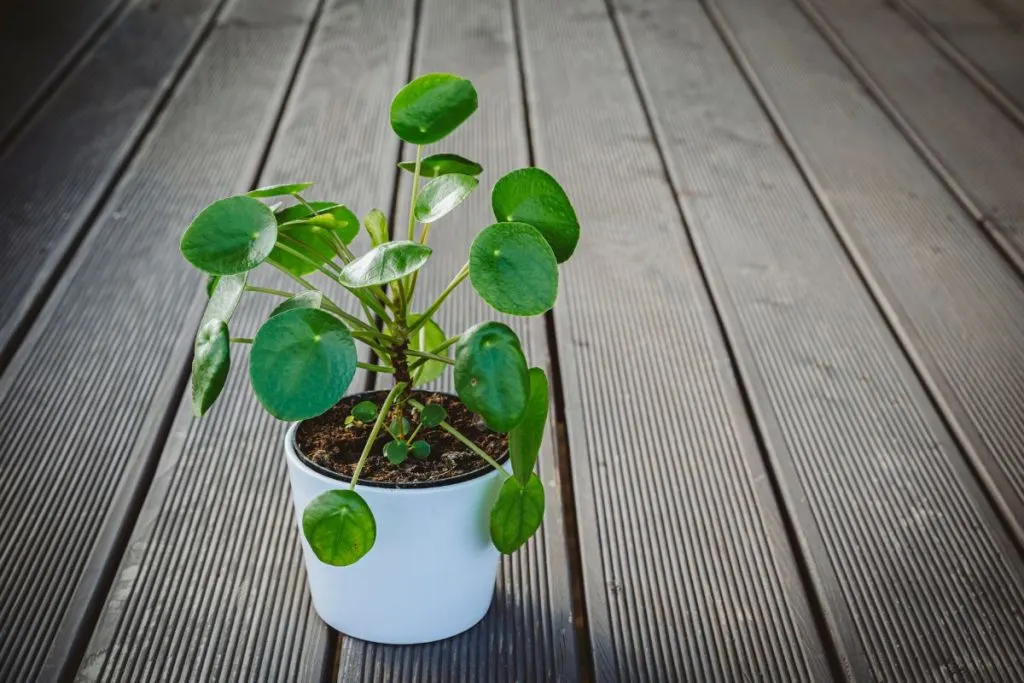
The Chinese dollar (Pilea peperomioides Diels) is an evergreen perennial from the Urticaceae family. He is originally from southern China. The first plant to be found in southern China in the Yunnan Mountains was in 1906 by Scottish botanist George Forrest.
- The coin plant is grown as a houseplant. We can keep it outside on warm days. The plant originates from a mountainous area but will not survive the winter. So with the arrival of autumn, you must bring it into the house.
- Propagation is possible by seed, but the plant does not bloom easily. Therefore, it is easiest to propagate it by cuttings by cutting the wooden stems and putting them in water until they take longer roots.
- Transplant them into new jars to which you have previously added loose compost soil. Frequent watering is suitable for plants, especially during hot days, but they tolerate hard and dry, neglected soil very well.
- It is good that the plant has more light, but not direct sunlight because otherwise, the leaves will fry. It grows well in a semi-shady place. There are no diseases or pests.
5. What To Know About Peperomia Rotundifolia?
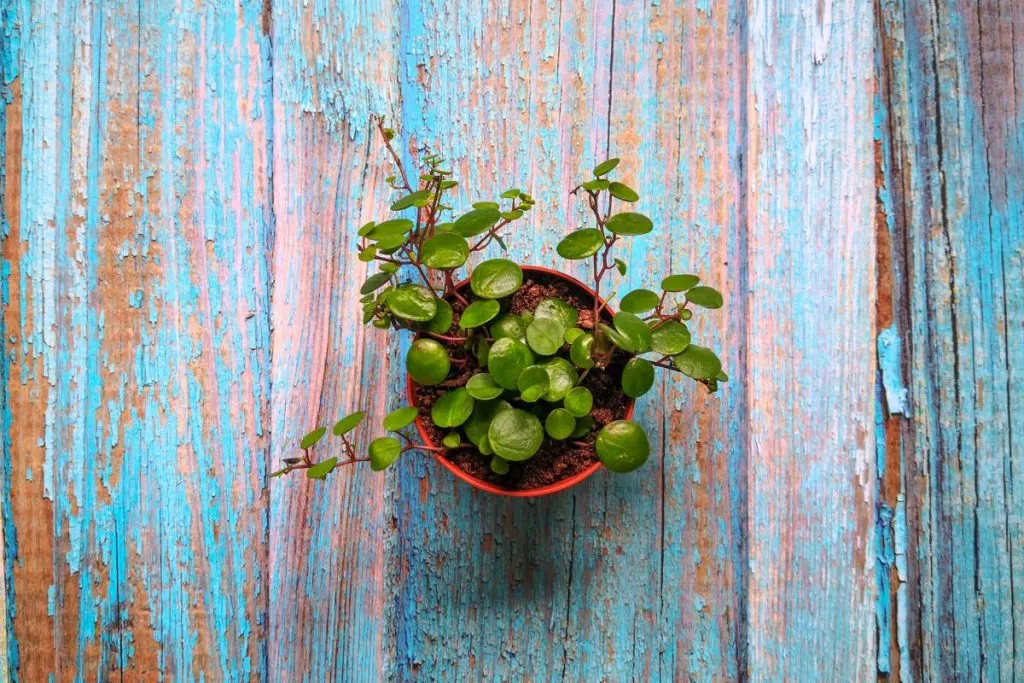
This wonderful round leaf peperomia (Peperomia Rotundifolia), also called Peperomia hope originates from Brazil. It is one of the famous tropical plants.
- This hybrid peperomia copes equally well in difficult conditions, but it is better not to place it near radiators in winter and air conditioners in summer.
- These peperomia epiphytes thrive in bright light or indirect sunlight, but too much light can cause their leaves to look dull and lifeless. The ideal placement of this variety is near the window facing southwest.
- Peperomia hope is a plant that is difficult to grow and requires well-drained and airy soil because the plant of hope does not like to sit in wet soil.
- The best soil for peperomia can be considered a rich mixture of pots with coarse sand, peat moss, perlite, or gravel.
- The only thing that is hard to learn about peperomia care is their watering needs. Water the peperomia every 8-14 days.
- You can also adopt the method of drying by soaking your houseplant Peperomia but allow the topsoil (2-3 inches) to dry before watering the plant again.
- You should fertilize them once a month or every other week during the growing season, but do not fertilize them during the winter months.
- The ideal time for transplanting is when you notice that the peperomia hope comes out of the pot, drainage hole, or starts to dry quickly.
- For best growth, go one inch larger for the size of the pot, fill the bottom with fresh soil mixture and plant the plant carefully in well-draining potting soil.
6. Keep Things Sweet With Peperomia Jelly!
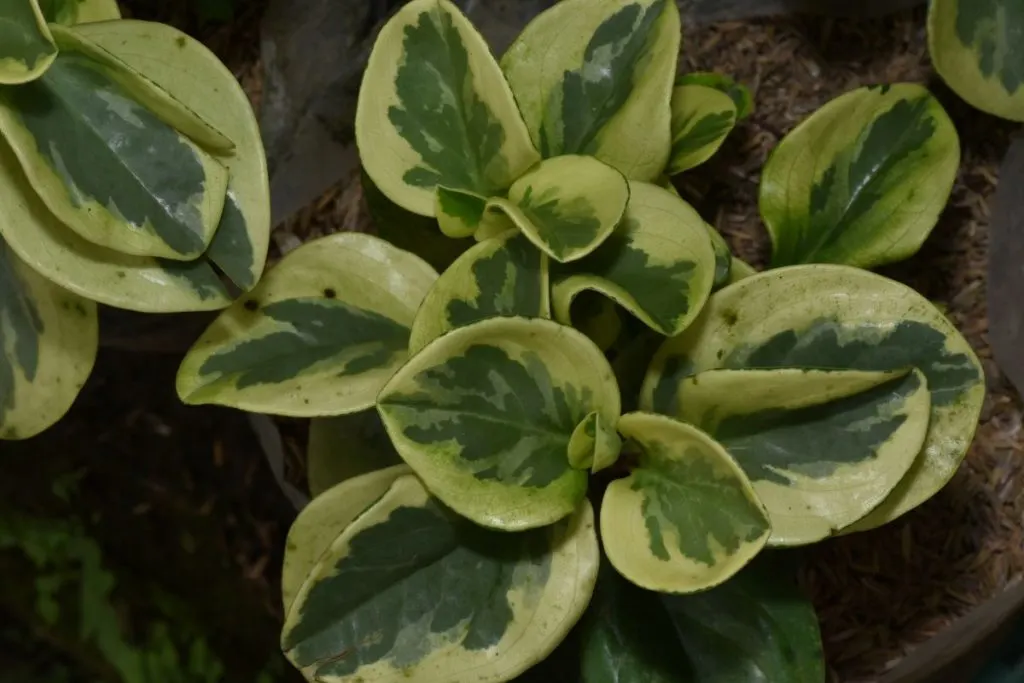
Peperomia jelly, red edge peperomia (Peperomia clusiifolia) has amazing almost shaped leaves that will freshen up your living room. It’s a slow grower but it will be worth the patience. When it finally starts growing it will have a bushy appearance.
Peperomia jelly is easily propagated by cutting stems with at least 3 internodes. These cuttings are taken from a plant well inflated by recent watering, in spring or summer.
- The cutting wound of peperomia is left to dry for a few days, and then part of the stem is partially incorporated into the soil.
- Peperomia Jelly enjoys a slightly humid atmosphere, for example, it likes to be associated with another plant. It needs acidic and draining soil, like peat compost, mixed with some gravel. Water it with rainwater every time the soil dries.
- This peperomia needs the brightest possible exposure, but without direct sunlight, because a lot of suns can cause burns, dry leaves, and even kill the plant. Insufficient light causes etiolated growth, making it messy and much less beautiful.
7. Spice It Up With String Of Turtles
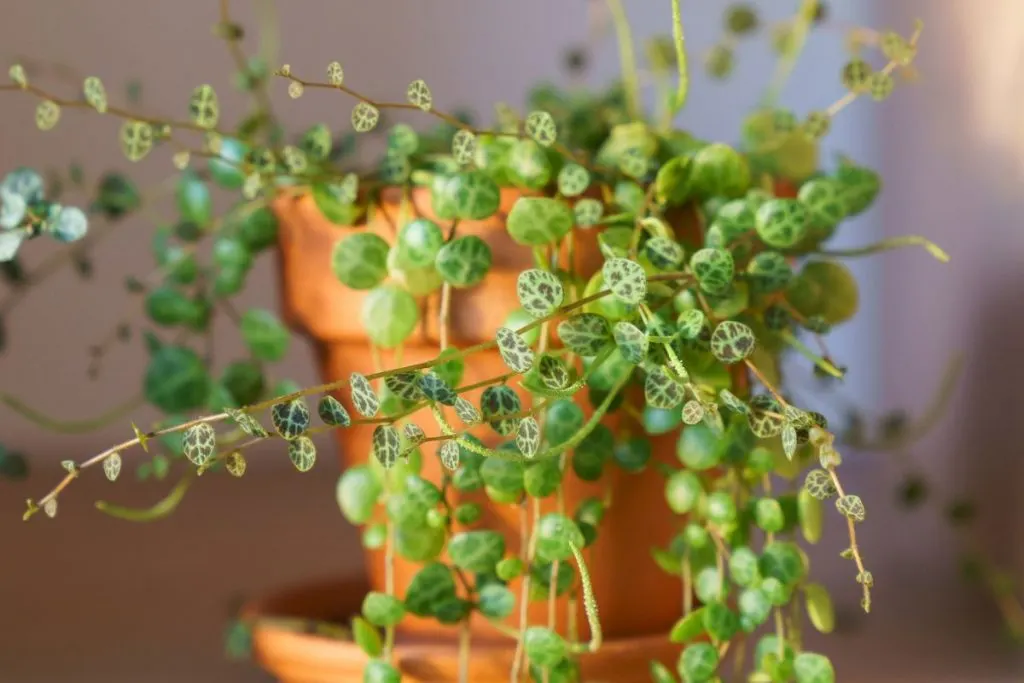
Also called cupid peperomia (Peperomia prostrata) is a perfect plant for hanging baskets. It is one of the trailing plants that will surely be a lovely treat for your home. It is very similar to trailing jade peperomia but when you look closer, they do have differences.
- They can be green or striped, marbled or bordered with pale green, red or gray, and some stems are red. The tiny flowers are inconspicuous and grow in the shape of prickly thorns. The fruit is a berry that eventually dries and shows pepper-like seeds.
- Plants can be divided and transplanted. They are removed and divided into smaller pieces, each with a few attached roots. Cuttings of leaves or stems can also be taken in spring or summer.
- Since it is a plant that was born with the impulse of life and is used only for ornamental purposes, it can easily grow at normal room temperatures. However, during harsh conditions, you may need to adjust the temperature by moving the pots and plant pots.
- Prostrata or rows of turtle plants are exotic indoor plant species that grow very well surrounded by walls and roofs.
- However, the area where you decide to place these dishes must get enough light and freshness. Please note, that we are not talking about direct sunlight.
- Do not prune the plant from time to time, as the plant will lose its balance and may even cause death. Check the soil of the plant after a few days and water it if you see that the soil is dry. Do not leave the soil too dry as peperomia grows faster in moist soil.
8. Parallel Peperomia Plants
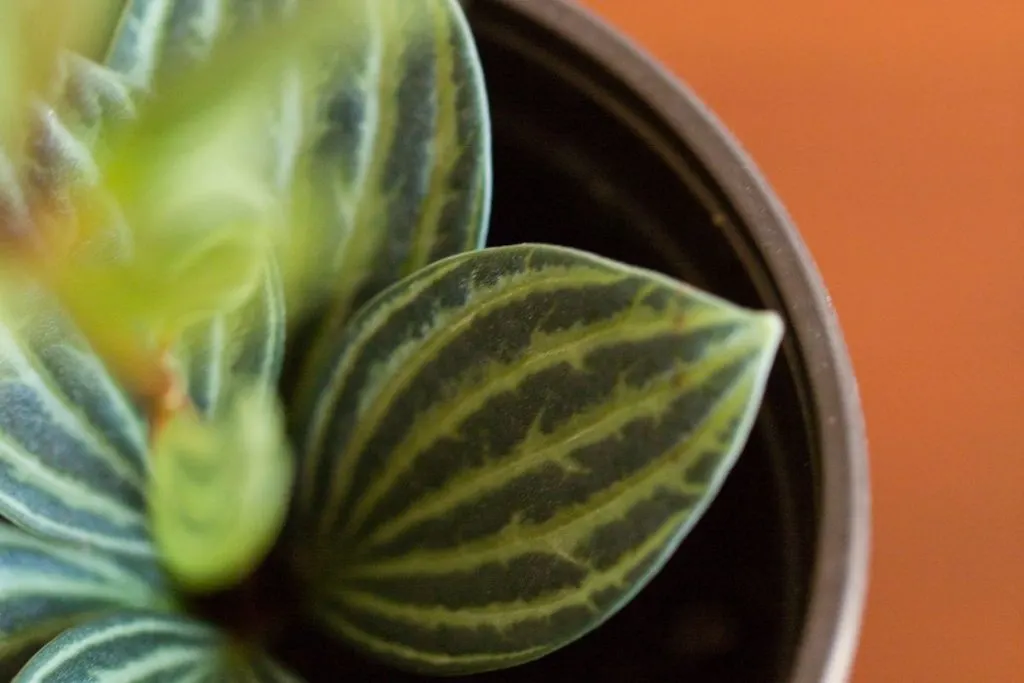
Some mix it with peperomia caperata or red ripple peperomia but a lovely (Peperomia puteolata) has a pretty unique geometrically shaped look.
- The plant Peperomia puteolata is a member of the pepper or family Piperaceae which consists of more than a thousand varieties of peperomia subtropical and tropical plants.
- Keep Peperomia puteolata in strong indirect sunlight. Direct sunlight will cause burning on the leaves. Lack of strong light will cause slow growth. Keep this tropical plant at a constant temperature of 65 -75 F.
- These semi-succulent plants have the same watering requirements as full succulents. Wait until the soil is almost dry, then ensure deep watering. If you wait too long, you may find that your Peperomia has withered leaves. Good deep watering will solve this problem.
- Use a well-drained soilless pot mixture consisting of one part perlite and two parts peat moss. The idea is to have a mixture that can retain a moderate amount of water while providing excellent drainage.
- Frequent repatriation is not required. Wait until your plant starts to outgrow its pot, then move it to the next size.
- Although this plant can be propagated by cuttings of the stem or leaves, the small size of the leaves makes cutting the tops of the stems more successful. How to cut this plant?
Cut off an inch or two of the top of the stem. Make sure the cut has at least one knot and a few leaves. Place the cuttings on a paper towel and twenty-four hours in a warm, airy, dimly lit place. This will allow the incision to dry and heal.
Place the cuttings in a small pot of moist planting mixture as described above. It is useful to dip the end of the cut first into the rooting hormone. Place the plastic bag loosely over the cuttings and place the container in a place suitable for maintaining the health of Peperomia.
9. How To Take Care Of Teardrop Peperomia
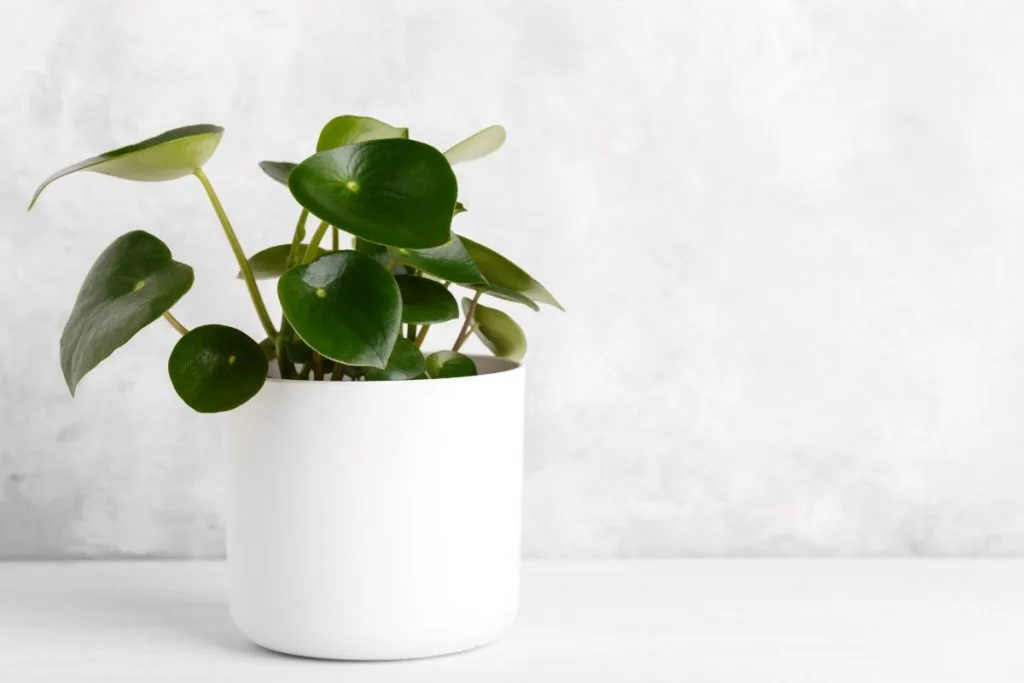
Also called the radiator plant, Teardrop peperomia (Peperomia polybotrya) is one of the most difficult houseplants to maintain. It is very demanding: you need warm temperatures, high relative humidity, and irrigation control.
- The weather must be warm. These are tropical plants so we don’t have to expose them to low temperatures. Moreover, if it falls below 50 F, we have to protect them, for example by putting them in a house or an enclosed balcony.
- Peperomia of tears is very demanding of light. If they are indoors, they should be placed in a room with windows, and/or in a room where there is a lot of light. In low light conditions, the leaves become soft and fall off.
- Her water needs are not great. Because it stores water in the leaves, which is why they are fleshy, it can withstand a small drought. However, it must be watered when the soil is dry. How to multiply Peperomia Tear?
Choose a healthy leaf and cut it at the base. Prepare a pot with juicy soil and water. Insert the sheet, burying them in the blade. You will soon see a new peperomia plant.
10. Find More About Emerald Ripple Peperomia
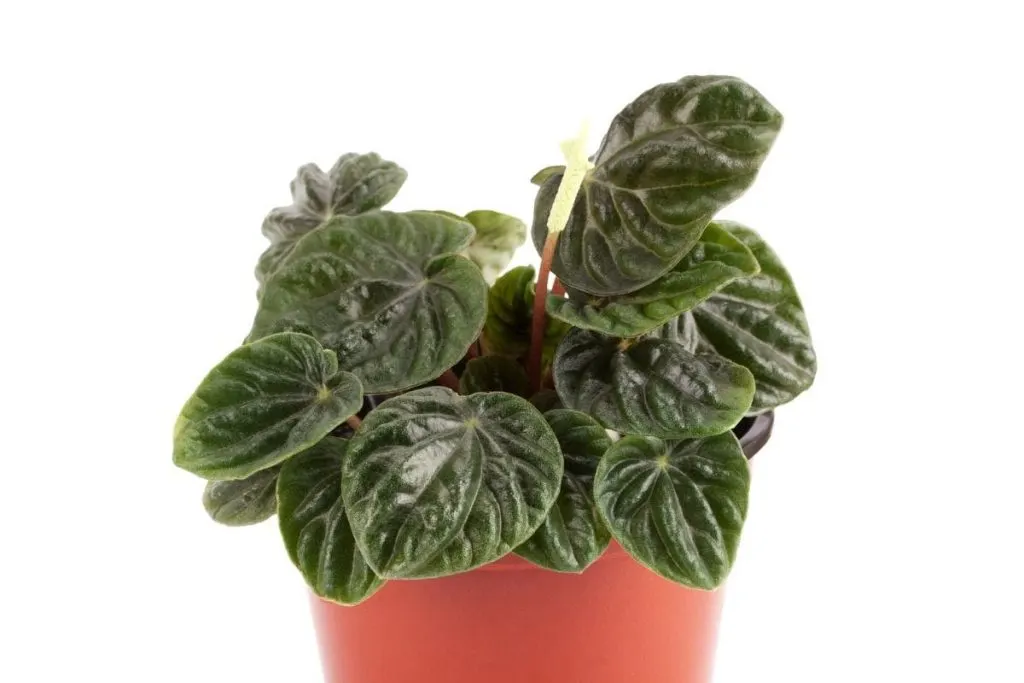
(Peperomia caperata) is one of the many species of the genus Peperomia from the Pepper family. In English-speaking countries, peperomia is called “radiator plant” – “radiator flower” and “baby ficus”.
- The plant is thermophilic and does not tolerate cold. You should keep the temperature at 60-65 F in summer and 70 F in winter.
- Abundant watering is needed during the growing season – in the spring-summer period, but excess moisture harms the root system. In the autumn-winter period, peperomia should be watered very moderately. Peperomia will not die if you don’t water it for a couple of days.
- The flower is photophilous, but can’t tolerate direct sunlight for a long time. Windows facing east or west are preferred. In winter, you can use fluorescent lights to extend daylight to 8-9 hours.
- Prepare the soil yourself by mixing grass, leafy soil, sand, and peat in a ratio of 1: 2: 1: 2. The soil must be light, otherwise, the root system will not be able to develop.
- Young plants are cut for decorative purposes – to form a bush. Adult shrubs do not tolerate this procedure well. First, the plant is carefully examined, choosing the shots that will be removed.
- These shoots are then cut with garden shears. In addition, they are sometimes removed and bloomed so that the young bush can gain strength.
- Use complex mineral fertilizers to feed the Lilian peperomia. From early spring to late autumn, feed it 2 times a month. Peperomia Lillian can be grown in a clay or plastic container. It should not be too big.
11. Types Of Peperomia: Peperomia Ruby Cascade
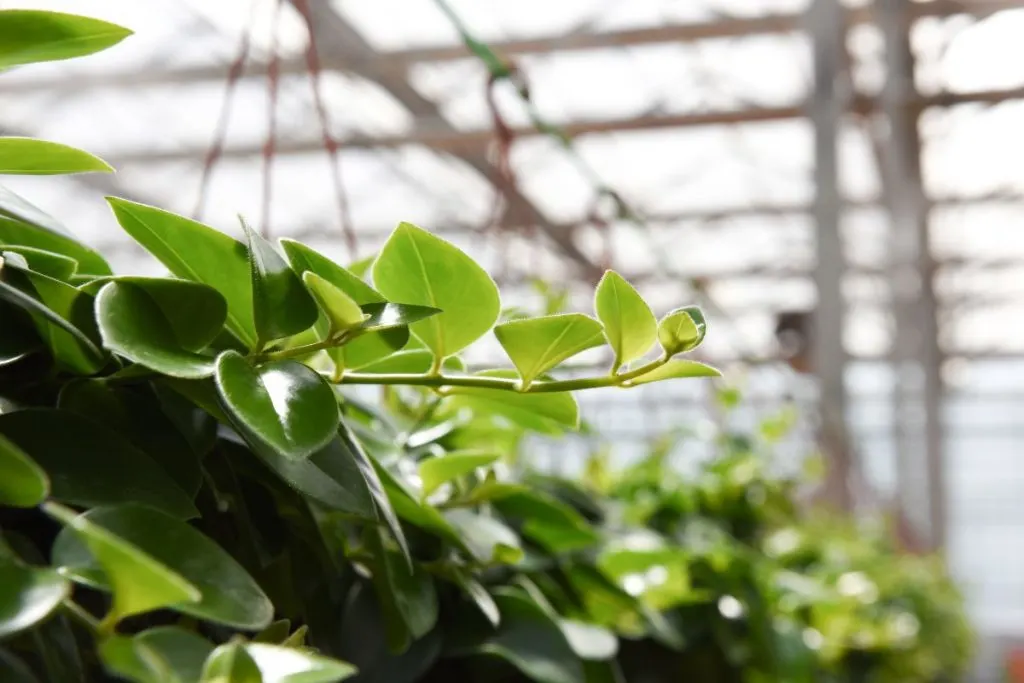
Ruby Cascade peperomia (Peperomia deppeana) also called trailing jade of peperomia gives reddish stems perfect for hanging baskets.
- It is not a tall plant, it reaches a few centimeters in height, but stems like vines can reach several meters if they are allowed to grow without grooming.
- If temperatures drop below 50 F in winter, grow them indoors or bring them indoors in winter. Fortunately, the peperomia cascade is a small plant that grows well in 3 to 5-inch pots.
- Just make sure it receives enough sunlight. Ruby Cascade needs bright, indirect sunlight, whether grown indoors or outdoors. It needs very little water, and excessive watering increases the risk of root rot.
- However, they still need more water compared to other succulents. Avoid keeping the soil completely dry for too long.
- Fertilize the plant with a diluted liquid fertilizer every other week during the spring and summer growing season. Do not fertilize it in autumn or winter.
- Frequent repotting can harm plants. Transplant mature plants in the spring, before new growth begins. Propagate peperomia ruby by cuttings or division. How to multiply or repot the peperomia ruby Cascade?
Divide the plants when transplanting in late fall. Carefully remove the plant and pull it into smaller pieces. Make sure each piece still has a few roots. To take cuttings, cut a stem at least 5 inches in size.
Remove the lower leaves and cut just below the lower joint. Place the cuttings on a bench and let them dry for an hour or two. This allows the incision to result in a blister. Plant cuttings or divided plants in well-drained soil or peat-based compost.
12. A Bit Of Rock ‘n’ Roll With Peperomia Metallica
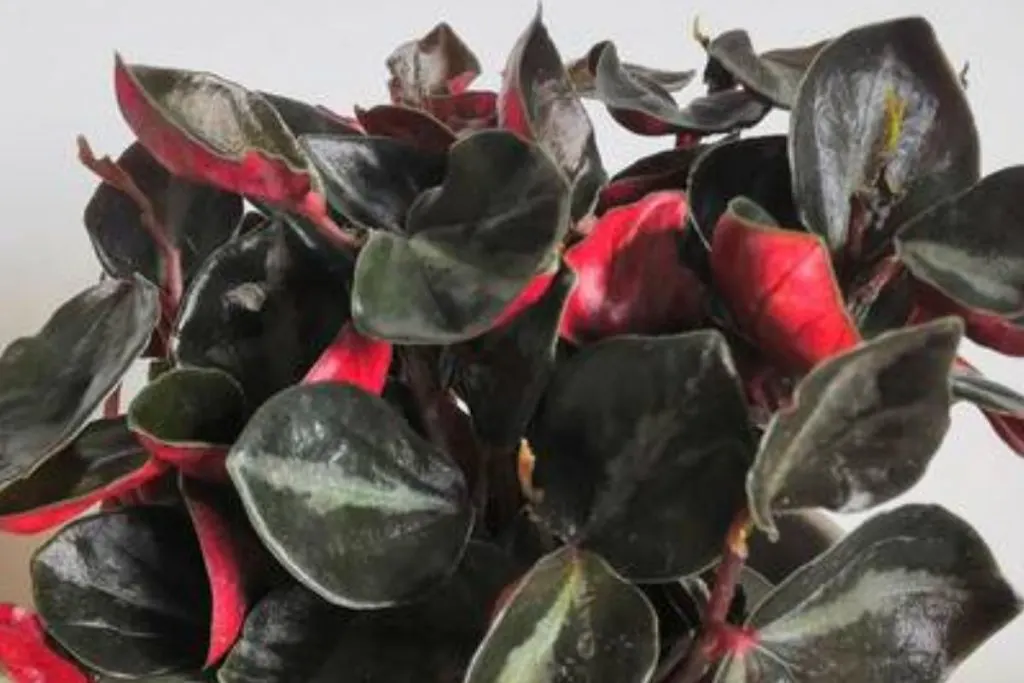
Peperomia Metallica is a small annual or perennial herbaceous evergreen plant, lush and compact, grown indoors mainly because of its ornamental leaves and small size.
It has thick (juicy) stems on which grow fleshy or leathery leaves, large and flat, colorful and nicely shaped.
- Peperomia Metallica especially appreciates repotting at the end of winter. Therefore, you can transplant it again after purchase if you notice that the roots protrude from the pot, and then once a year at the end of winter.
- It is best to transplant into a pot that is only slightly larger than the previous one because peperomia likes to feel cramped. The pot should have a drainage layer on the bottom. Use pebbles or clay balls for this.
- Place your peperomia behind a window that receives the sun only in the morning or evening. Avoid too dark a room at all costs as this peperomia is also afraid of shade. Peperomia with green leaves need good light, but they should be protected from full sun.
- She needs a lot of water, but it is useful to over-water because too much watering could kill her.
13. Types of Peperomia: Peperomia Graveolens
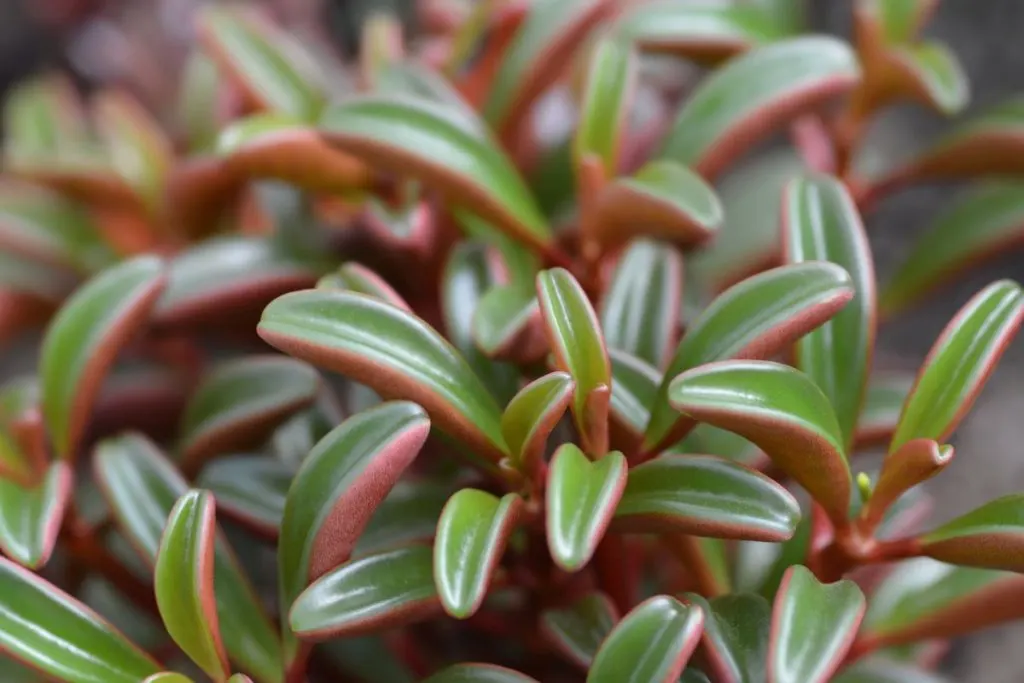
(Peperomia graveolens) is a succulent plant grown in the houseplant, belonging to the family Pépéromiacées or Piperaceae.
Although they are harder to grow than the usual crassula, Peperomia graveolens is a specie, well adapted to the interior.
- When planting it, you should be careful with the seasons and conditions that will determine whether your plant will grow or not. Learn all the tips you need to know about when to plant and how to plant peperomia.
- The best season in which you can plant Peperomia graveolens is during the spring season. The plant will need favorable conditions that will allow faster growth. You can transplant during the spring. Use a suitable container when reloading.
- When you want to plant Peperomia graveolens, make sure you use suitable soil. Wet soil rich in humus will be great. You can still opt for cactus soil because they all show the best salt drainage abilities. The best way to plant is to propagate.
- Use cuttings from the stem of the main plant, where you will let it be numb for a while before transferring it to well-drained soil. Watering is not necessary, except when the soil is dry.
- Peperomia graveolens are effortlessly propagated by cuttings. Use a sterile, sharp knife or scissors, discard the stem with the leaves from the predominant plant and let it feel numb for a few days before being placed on well-drained soil.
Why Are The Leaves Of My Peperomia Suddenly Light Green?
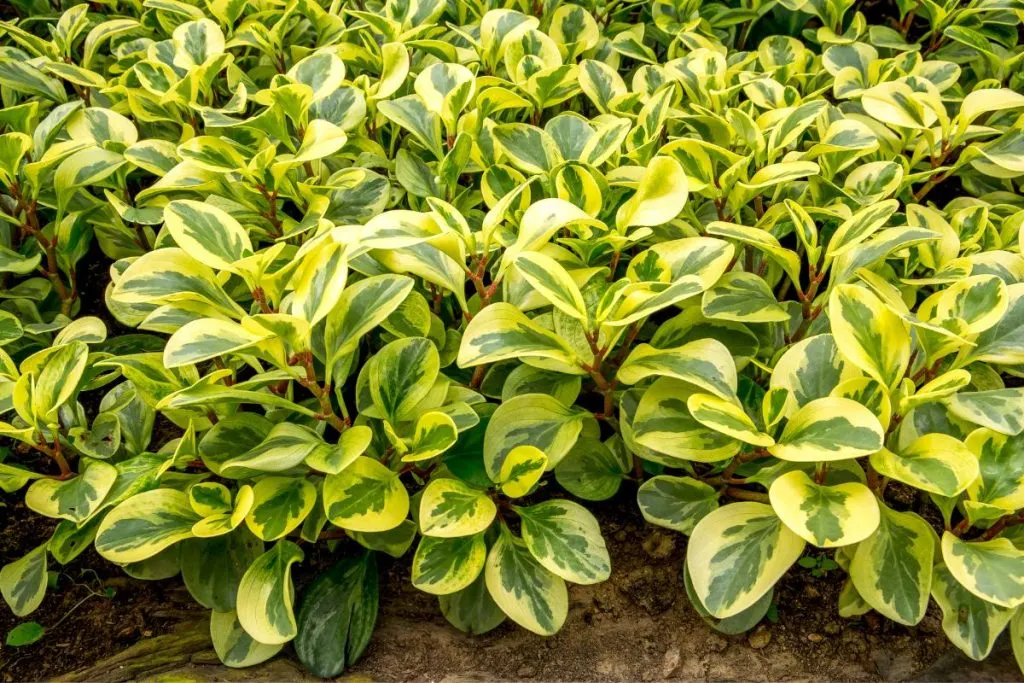
We can see the yellow color due to the pigment xanthophyll. Carotene is responsible for the yellow and orange colors.
– It dissolves in the cell sap of the leaf, and the amount of pigment increases with strong light and lower temperatures. Pigments of all these colors are always present in the cells of the plant, but in the period of active production of chlorophyll, the green color overlaps with everything else.
– But the leaf turns brown when it completely loses its color pigments. At that moment, empty cell walls become visible to us, which have a brown color.
– As a rule, the color of the leaves changes in autumn, because the level of vital activity of plants decreases at this time of year.
– It is getting colder outside, and the trees are getting less and fewer nutrients from the ground. Chlorophyll begins to break down.
– At the same time, its most active destruction is happening in the light. If the weather is cloudy and rainy outside, then oaks, maples, and birches will stay green longer.
– In hot and dry summers, when plants lack moisture and have enough sunlight, the leaves can also lose chlorophyll and green color.
Is Peperomia Pink Lady Rare Peperomia Variety?
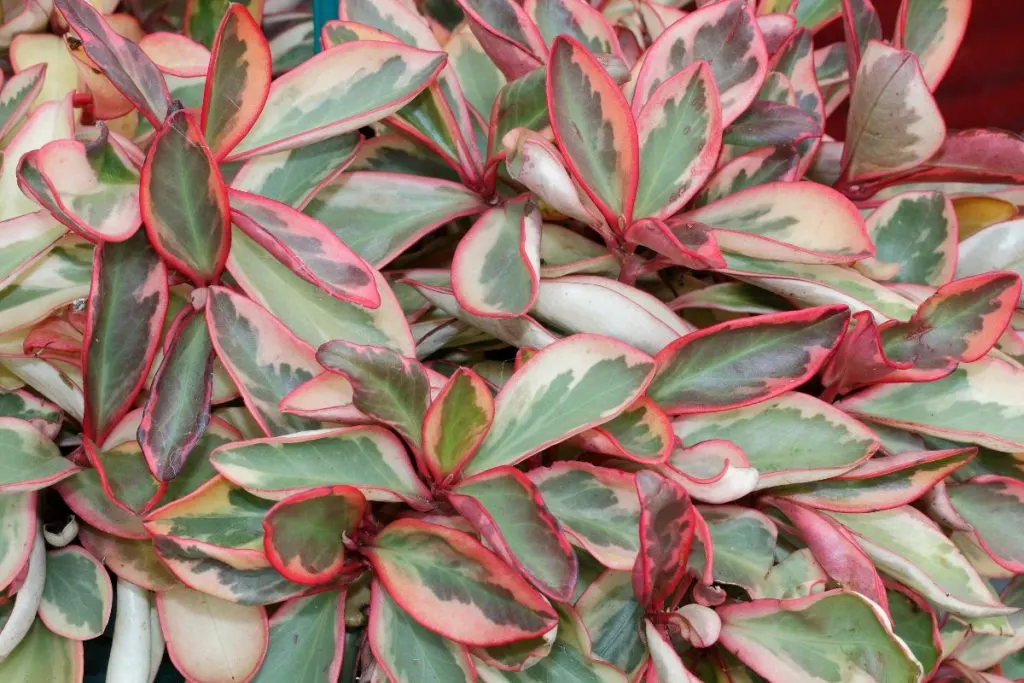
There are peperomia species that are very rare and unlike the varieties above, we can’t get them or buy them as soon as these mentioned types. One of those species is pink lady peperomia.
Peperomia Marmorata is a plant that you will wait for a bit longer than you’re used to. I’m sure, however, that your florist will do her/his best to get it for you.
Once you do, you will completely forget about the waiting part. Its lovely colorful leaves will make you speechless and you’re going to hallow it!
That Is All For Today About Types Of Peperomia
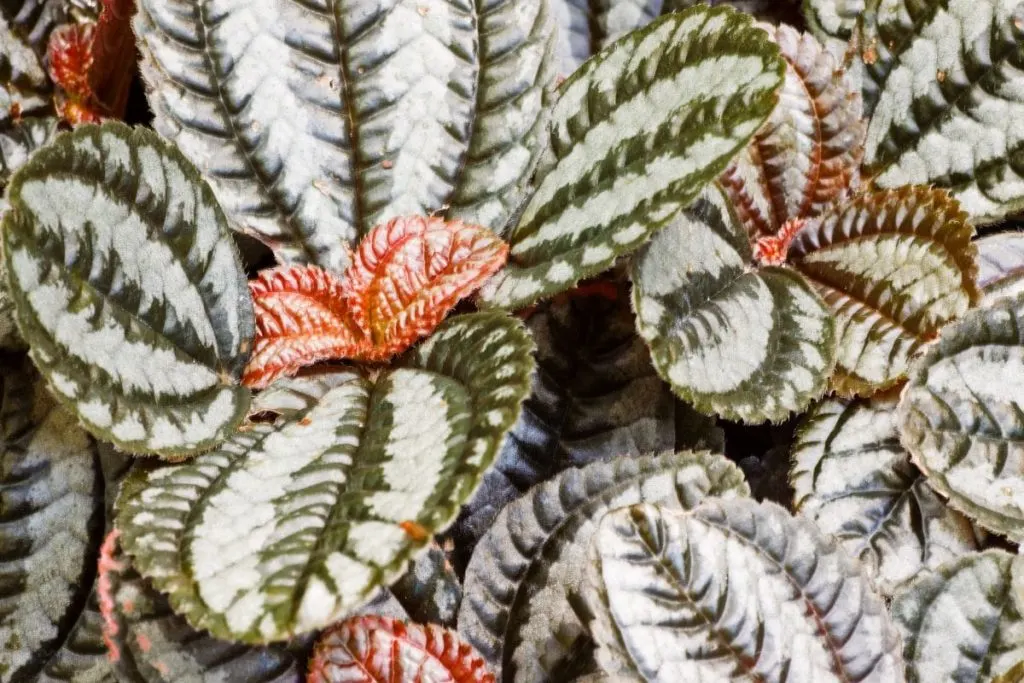
There are many types of peperomia that we didn’t mention today. That doesn’t mean they’re not a good opinion as a plant for your home. They are, we just pointed out the most popular types for you.
You can always search for other types as well: peperomia perciliata, peperomia quadrifolia, ruby glow peperomia, peperomia japonica, dwarf watermelon peperomia, red twist peperomia, peperomia orba, peperomia scandens etc.
These varieties will be good options for your lovely home as well. We hope you learned much with us today about peperomia and of course, you’re more than ready now to get one for yourself.

